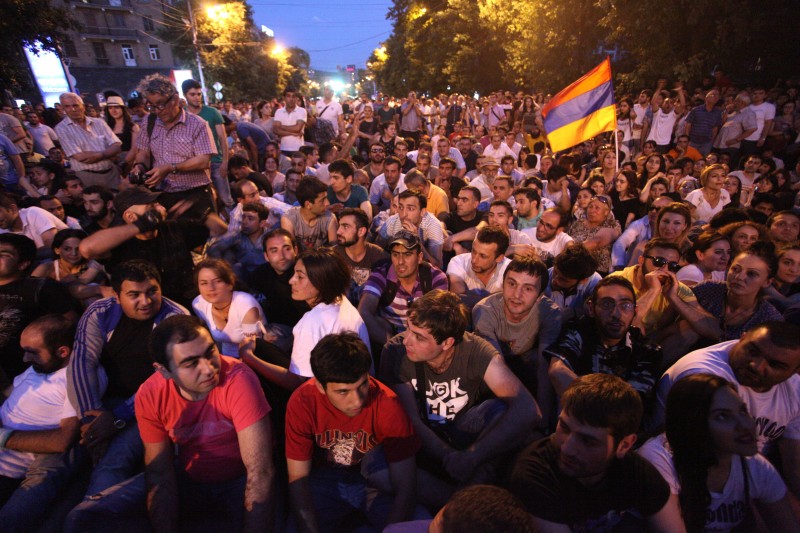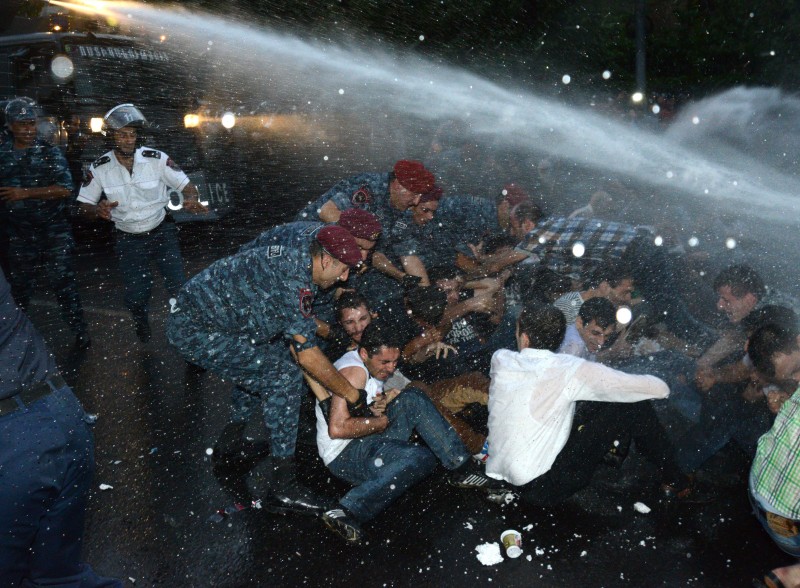
Protesters demonstrate near the Presidential Palace in Yerevan on 22 June. Demotix/PHOTOLURE News Agency/7924537.
Armenians are engaging in a defiant act of civil disobedience.
Thousands of residents of the national capital Yerevan have taken to the streets [1] to voice their unhappiness with electricity rate hikes.
The June 19 sit-in followed the announcement by the government of President Serzh Sargsyan two days earlier that a 16 percent increase in electricity tariffs would go into effect on August 1.
The announcement was met with predictable dismay, but the Public Services Regulatory Commission — the national energy regulator — claimed that the hike was unavoidable.
The Armenian electricity grid is owned by the Russian company Inter RAO UES, which claims tariff increases were necessary because of a drop in the value of the Armenian national currency, the dram. Protesters have demanded [2] that the president cancel the rate increase.
An incensed citizenry moved towards the Presidential Palace early Tuesday in what media have dubbed ‘Electric Yerevan’.
5,000 protesters congregated in front of the palace, railing against electricity rate hikes and the administration's failure to combat poverty in Armenia, the poorest country per capita in the South Caucasus [3].
Demonstrators violently dispersed
Police cracked down hard on protesters. A total of 237 people were arrested early Tuesday near the Presidential Palace, including prominent journalists Ani Hovhannisian and Hrant Galstian [4].
Riot police used batons and water cannons [5] to disperse demonstrators. The AFP news agency reported that policemen physically assaulted journalists on the scene.

Police use water cannons to disperse demonstrations in Yerevan on 23 June. Demotix/PHOTOLURE News Agency/7926046.
Not to be deterred, a reported 6,000 protesters made a second march on the Presidential Palace on Tuesday evening.
Journalist Onnik James Krikorian, who lived in Armenia for 14 years before being based in neighbouring Georgia, expressed concern for the demonstrators’ physical well-being:
Time for bed. Hoping I don't wake up to news of another dispersal. Touch wood it doesn't look like that for now… #electricYerevan [6] #Armenia [7]
— Onnik J. Krikorian (@onewmphoto) June 23, 2015 [8]
Seven demonstrators and 11 police officers were reported injured as of Wednesday morning.
Sounding off
Natalya Harutyunan, a project manager at UNDP Armenia, saw the protests as about more than just electricity prices:
Importantly, it isn't a power battle, but genuine #citizenry [9] demand for transparent and fair policy decision-making #ElectricYerevan [10]
— Natalya Harutyunyan (@nata_har) June 24, 2015 [11]
Monica Ellena, a Tbilisi-based freelance journalist, had this to say:
#Armenia [7] #ElectricYerevan [10] electricity hike, a tipping point for young Armenians (and not only) http://t.co/pnB1HlBfG5 [12]
— monica ellena (@monicaellena) June 24, 2015 [13]
Global Voices correspondent Karena Avedissian [14] responded to assertions that the demonstrations are an outlet for anti-Russian sentiment:
Again, no this isnt a maidan, but the electric company that the protests are against is Russian-state owned. Can't ignore Russian complicity
— Karena Avedissian (@KarenaAv) June 23, 2015 [15]
While many voices view Electric Yerevan as an emerging social movement, others see it on simpler terms.
A 24-year-old former government employee told Global Voices on condition of anonymity that “the reason is very simple. People went to the streets to protest against the rise of electricity rates. That's it.”
Yerevan-based political scientist Akop Gabrielyan also cautioned against drawing broad conclusions when contacted by Global Voices:
The cause, deep-rooted social reason is tied with a number of unpopular moves and decisions by the government: rise of taxes, transport prices, etc. At the same time it is completely wrong to call the movement as the Armenian Maidan … People are against ineffective, detrimental management of the electricity company.